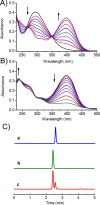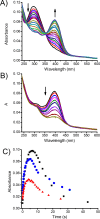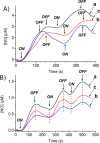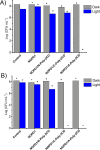Stepwise Nitric Oxide Release and Antibacterial Activity of a Nitric Oxide Photodonor Hosted within Cyclodextrin Branched Polymer Nanocarriers
- PMID: 38894929
- PMCID: PMC11181500
- DOI: 10.1021/acsmedchemlett.4c00061
Stepwise Nitric Oxide Release and Antibacterial Activity of a Nitric Oxide Photodonor Hosted within Cyclodextrin Branched Polymer Nanocarriers
Abstract
A hydrophobic nitric oxide (NO) photodonor integrating both nitroso and nitro functionalities within its chromophoric skeleton has been synthesized. Excitation of this compound with blue light triggers the release of two NO molecules from the nitroso and the nitro functionalities via a stepwise mechanism. Encapsulation of the NO photodonor within biocompatible neutral, cationic, and anionic β-cyclodextrin branched polymers as suitable carriers leads to supramolecular nanoassemblies, which exhibit the same nature of the photochemical processes but NO photorelease performances enhanced by about 1 order of magnitude when compared with the free guest. Antibacterial tests carried out with methicillin-resistant Staphylococcus aureus and Acinetobacter baumannii demonstrate an effective antibacterial activity exclusively under light activation and point out a differentiated role of the polymeric nanocarriers in determining the outcome of the antibacterial photodynamic action.
© 2024 American Chemical Society.
Conflict of interest statement
The authors declare no competing financial interest.
Figures








Similar articles
-
A phototherapeutic fluorescent β-cyclodextrin branched polymer delivering nitric oxide.Biomater Sci. 2019 May 28;7(6):2272-2276. doi: 10.1039/c9bm00395a. Biomater Sci. 2019. PMID: 31033967
-
Supramolecular red-light-photosensitized nitric oxide release with fluorescence self-reporting within biocompatible nanocarriers.J Mater Chem B. 2024 Jul 3;12(26):6500-6508. doi: 10.1039/d4tb00325j. J Mater Chem B. 2024. PMID: 38873736
-
A calix[4]arene-based ternary supramolecular nanoassembly with improved fluoroquinolone photostability and enhanced NO photorelease.Photochem Photobiol Sci. 2019 Sep 1;18(9):2216-2224. doi: 10.1039/c9pp00011a. Epub 2019 Mar 11. Photochem Photobiol Sci. 2019. PMID: 30855613
-
Cyclodextrin: A prospective nanocarrier for the delivery of antibacterial agents against bacteria that are resistant to antibiotics.Heliyon. 2023 Aug 24;9(9):e19287. doi: 10.1016/j.heliyon.2023.e19287. eCollection 2023 Sep. Heliyon. 2023. PMID: 37662769 Free PMC article. Review.
-
Sugar-based amphiphilic polymers for biomedical applications: from nanocarriers to therapeutics.Acc Chem Res. 2014 Oct 21;47(10):2867-77. doi: 10.1021/ar4003009. Epub 2014 Aug 20. Acc Chem Res. 2014. PMID: 25141069 Review.
Cited by
-
A calix[4]arene-based supramolecular nanoassembly targeting cancer cells and triggering the release of nitric oxide with green light.Beilstein J Nanotechnol. 2025 Jul 3;16:1003-1013. doi: 10.3762/bjnano.16.75. eCollection 2025. Beilstein J Nanotechnol. 2025. PMID: 40625378 Free PMC article.
References
-
- Ignarro L. J.Nitric Oxide: Biology and Pathobiology; Elsevier: St. Louis, 2010.
-
- Tewari D.; Sah A. N.; Bawari S.; Nabavi S. F.; Dehpour A. R.; Shirooie S.; Braidy N.; Fiebich B. L.; Vacca R. A.; Nabavi S. M. Role of nitric oxide in neurodegeneration: function, regulation, and inhibition. Curr. Neuropharmacol. 2020, 19, 114–126. 10.2174/1570159X18666200429001549. - DOI - PMC - PubMed
LinkOut - more resources
Full Text Sources

